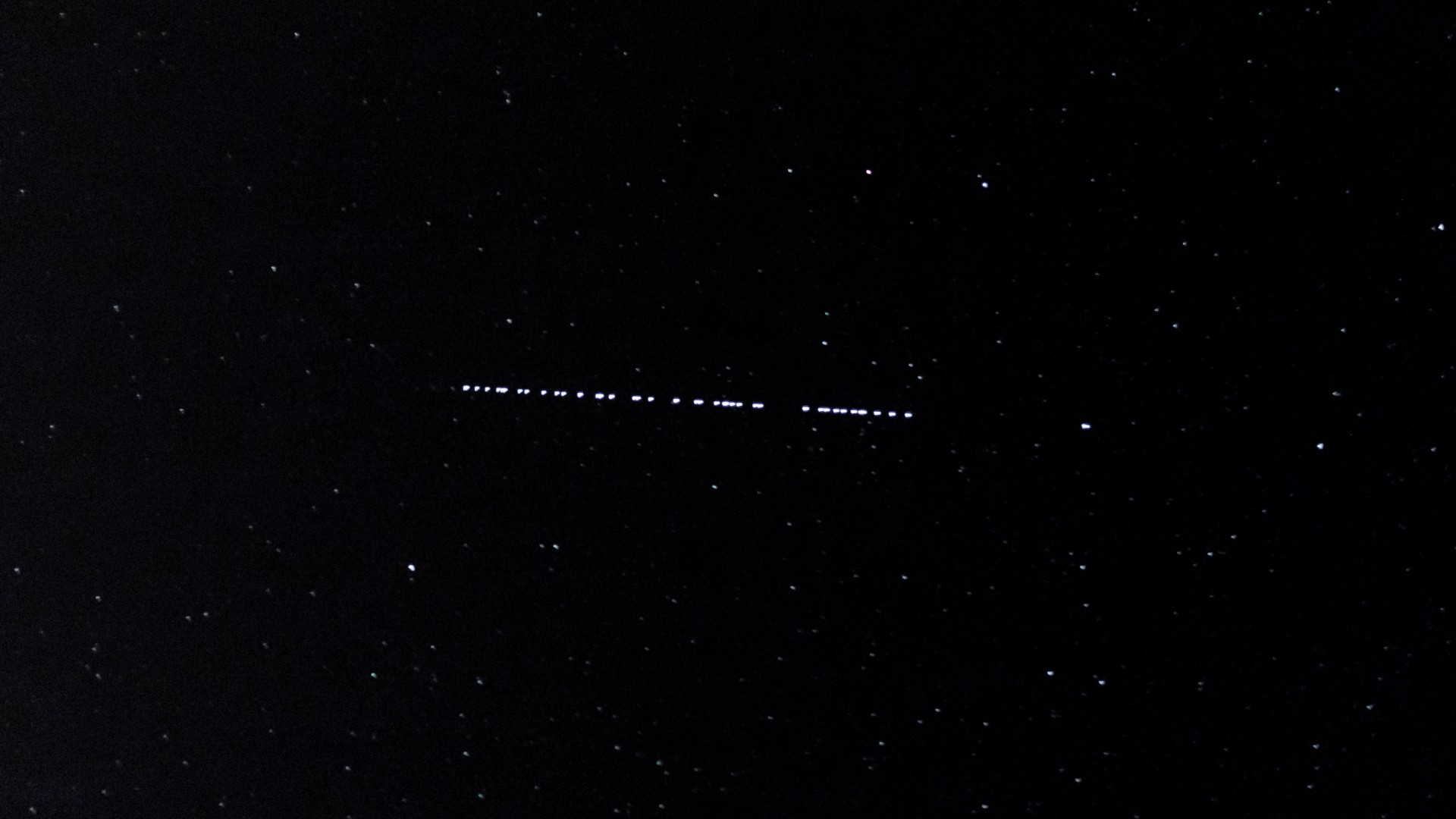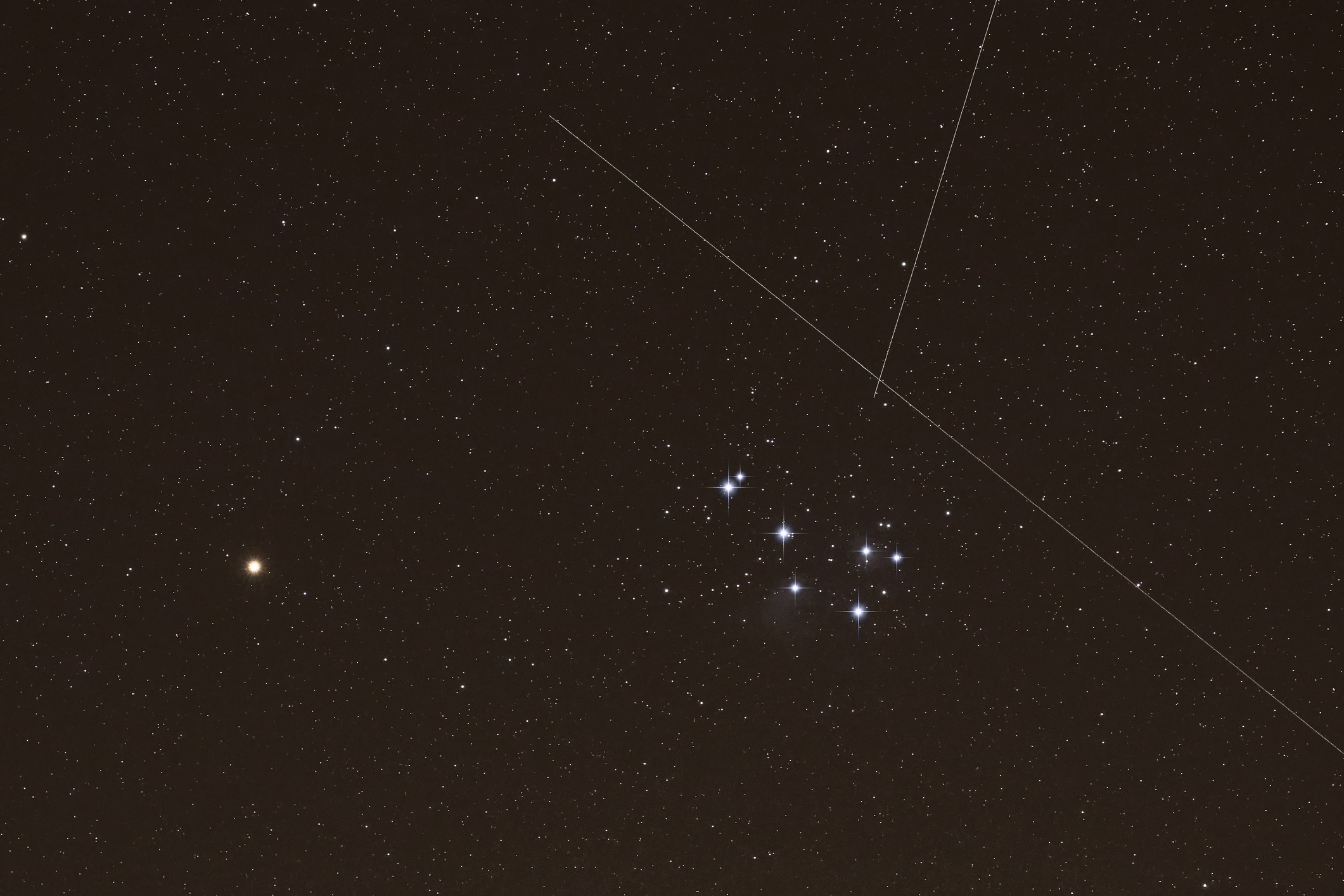World Space Week: Sustaining astronomy in an age of satellite megaconstellations
Thousands of satellites in the night sky are not only ruining the beauty of the stars, but are seriously hampering astronomers and pose a very serious space debris threat.

There were 4,852 active satellites in orbit around Earth at the beginning of 2022, and the number is growing rapidly.
The night sky is a resource open to all of us, but it's rapidly becoming a 'tragedy of the commons' scenario. Thousands of satellites in the night sky are not only ruining the beauty of the stars, but are seriously hampering astronomers and pose a very serious space debris threat.
As World Space Week this year looks at the message of sustainability in space, it is important to ask: Are we reaching a point where the number of satellites in the night sky is becoming unsustainable?
Related: Wow! Shiny SpaceX Starlink satellites soar with glowing aurora in stunning video
Where does it end?
SpaceX's Starlink internet satellite constellations now number more than 2,300 satellites with many thousands more on the way. Other internet providers also have plans to launch hundreds or thousands of satellites. In the latest turn of events, AST SpaceMobile's BlueWalker 3 communications satellite launched on Sept. 10, 2022 with a highly reflective 693-square-foot (64.4-square-meter) antenna that could shine brighter than anything in the sky other than Venus, the moon and the sun.
There are plans for more BlueWalker launches in the future, with even larger antenna arrays. SpaceX, meanwhile, wants to launch Starlink Generation 2, totaling 30,000 satellites. In total, various companies around the world are proposing to launch 400,000 satellites in the near future.
"We're sitting at a crucial branching point," said Andy Lawrence, Regius Professor of Astronomy at the University of Edinburgh, in an interview with Space.com. Lawrence has campaigned against the unregulated expansion of satellite constellations, writing a book on the topic called Losing the Sky.
Get the Space.com Newsletter
Breaking space news, the latest updates on rocket launches, skywatching events and more!
In addition, he has appeared as an expert witness in a legal case brought by a U.S. company, ViaSat, against the Federal Communications Commission (FCC) for excluding Starlink and other satellite constellations from being subject to environmental assessments. Although ViaSat lost their case, it was on a technical basis, and so a court has yet to crucially rule whether or not satellite constellations are exempt from environmental scrutiny. This is important because the FCC is currently considering SpaceX's proposal for their Gen 2 constellation.
"Starlink Gen 2 has made a request for 30,000 satellites, and they're ten times bigger [than the generation 1 satellites]," said Lawrence. "So this really is a crucial point. The FCC is really the gatekeeper on the decision of whether to go ahead with this."

Damaging Astronomy
Satellite megaconstellations are bad news for astronomers of all kinds. Long, deep exposures of the night sky become disfigured by the streaks of satellites passing through the field of view. The work of the Vera C. Rubin Observatory in Chile, with its 26.2-foot (eight-meter) survey telescope that is set to begin science operations later this decade, is under threat from the growth of satellite constellations. Asteroid hunters increasingly find the trails of satellites rather than the fainter streaks of potentially hazardous near-Earth asteroids. Astrophotographers discover their hard work spoiled by intruding satellites, and radio astronomers are in danger of being drowned out by the incessant chatter of satellites.
While there are ways around these problems — writing software to try and remove the satellite trails from images, or pausing exposures if there is a satellite passing over head, for example — it ultimately results in more work that costs more money, says Lawrence.
"It's a percentages game, because it won't make any particular type of astronomy suddenly impossible, but it does mean that we will miss some things, it will all get harder," said Lawrence. "We're developing software to try and take satellite streaks out, and that will work to some extent but not completely, depending upon how bright they are. We may just have to accept our losses, that a certain fraction of images will be ruined."
Lawrence and fellow astronomers aren't ready to throw in the towel just yet. He's also keen to point out that they're not being luddites. Satellite internet clearly has very important uses, as we have seen recently with Starlink bringing emergency internet connection to areas of Florida hardest hit by Hurricane Ian, or providing internet access to Ukraine during the ongoing Russian invasion.
"Those of us who are concerned just want to say, 'whoa, slow down'," said Lawrence. "Let's do some independent environmental assessments, they may take a couple of years and that might be uncomfortable for SpaceX, but they're so far ahead of the competition that they should be able to live with that."

Mitigation attempts
It would be unfair not to mention that engineers from SpaceX and one of its rival satellite companies, OneWeb, are working with astronomers to try and find solutions to these problems.
"They do speak to astronomers, and there are parts of their organizations that are quite serious about that," said Lawrence. "They want to help because astronomy is cool. For example, the engineers at SpaceX are working really hard on experiments such as VisorSat and new dark coatings [to make the satellites less reflective], but its all about mitigating the problems, and the only way to really mitigate them is to launch just 3,000 instead of 30,000."
Then there's the problem of space debris. The more satellites there are in orbit, the greater the chance of collisions between them, scattering debris across Earth orbit. These collisions can increase the chance of further impacts that produce even more debris in a runaway effect that, in the worst and most extreme scenario, could make launching new spacecraft too dangerous because there would be too much debris circling the Earth. It's called the Kessler syndrome, and it's beginning to become a real concern for some in the satellite industry.
"The debris problem is really quite worrying," said Lawrence. "It could end up being disastrous, and the whole industry could shoot itself in the foot. Some people in the industry are very concerned about it, but it's almost like, if it's going to be bad then we better get in there quick before it becomes impossible to launch a new satellite without it getting taken out by shrapnel."
Read more: Kessler Syndrome and the space debris problem
That would be the very definition on unsustainability, but Lawrence is keen to emphasize that we haven't reached that point yet. Much will depend upon the FCC's decision regarding Starlink Gen 2 and environmental assessments for satellite constellations in general. In the United Kingdom there have been discussions about having the equivalent of a 'Kitemark' (in the U.K. this is a certification that a product has been safety tested), where investors and insurers could buy into satellite internet, for example, knowing that it has been environmentally assessed and is mitigating its impact.
In the United States, Moriba Jah, a professor of aerospace engineering at the University of Texas at Austin, is leading an initiative called the Space Sustainability Rating that is connected to the World Economic Forum and encourages responsible behavior from satellite providers.
Taking Part
You, too, can get involved, by participating in a letter writing campaign to the FCC ahead of their decision regarding Starlink Gen 2.
"Anyone can write a letter to the FCC and say what they think," said Lawrence. "With my friends at ViaSat, I've put together instructions on how to write a letter to the FCC, and that seems to be slowly working with a number of people having written letters."
Lawrence recommends keeping letters short, describing how satellite constellations could adversely affect your own experience of the night sky, and how they are bad for both science and the sustainability of commercial activities in Earth orbit. You can find Lawrence's advice here.
So what would be a sustainable number of satellites? Lawrence admits he's not sure. "My gut instinct is that we've not passed that point yet, but we will if we end up with 400,000 satellites. But I think this is a battle that, while I hesitate to say 'win' because we're not really trying to beat someone, we can hopefully arrive at a sensible solution."
For more details, you can also visit the website of the International Astronomical Union's Center for the Protection of the Dark and Quiet Sky from Satellite Constellation Interference, or CPS.
Follow Keith Cooper on Twitter @21stCenturySETI. Follow us on Twitter @Spacedotcom and on Facebook.
Join our Space Forums to keep talking space on the latest missions, night sky and more! And if you have a news tip, correction or comment, let us know at: community@space.com.

Keith Cooper is a freelance science journalist and editor in the United Kingdom, and has a degree in physics and astrophysics from the University of Manchester. He's the author of "The Contact Paradox: Challenging Our Assumptions in the Search for Extraterrestrial Intelligence" (Bloomsbury Sigma, 2020) and has written articles on astronomy, space, physics and astrobiology for a multitude of magazines and websites.









